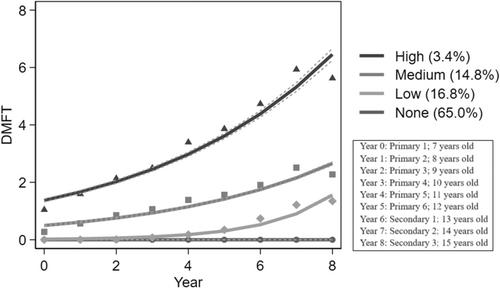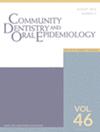Caries trajectories from childhood to adolescence: Analysis of data from a nationwide school dental service
Abstract
Objectives
The aim of the study was to assess patterns of longitudinal changes in caries status among school-going children in Singapore.
Methods
Dental records for a single cohort of students who received dental examinations in six standard examination years between 2009 and 2017 were analysed (n = 24 699). Group-based trajectory modelling with a zero-inflated Poisson distribution was carried out to determine dental caries trajectories in the permanent dentition. Associations between sociodemographic factors and trajectory group membership were assessed using multinomial logistic regression.
Results
The predicted population distribution across the four caries trajectory groups identified was 65.0% (‘none’), 16.8% (‘low’), 14.8% (‘medium’) and 3.4% (‘high’). The ‘none’ trajectory group had a decayed, missing and filled teeth (DMFT) score of 0 throughout the 8 years. Higher baseline DMFT counts and nonlinear increases in DMFT scores were noted for the ‘low’, ‘medium’ and ‘high’ trajectory groups. The correlation coefficient between DMFT counts in years 6 and 8 was 0.91, as compared to 0.77 between baseline and year 1. Factors associated with the ‘high’ caries trajectory include lower socio-economic status, female gender, Chinese race (compared to the Indian race), enrolment in primary schools in the Eastern and Western regions of Singapore, and enrolment in public secondary schools.
Conclusions
Under a nationwide school dental service, four trajectory patterns of caries counts in the permanent dentition were identified over 8 years. Among students in the ‘low’, ‘medium’ and ‘high’ trajectory groups, greater caries increment was noted during the transition from primary to secondary school. The correlation between DMFT counts in successive examinations was stronger in older than younger ages.


 求助内容:
求助内容: 应助结果提醒方式:
应助结果提醒方式:


